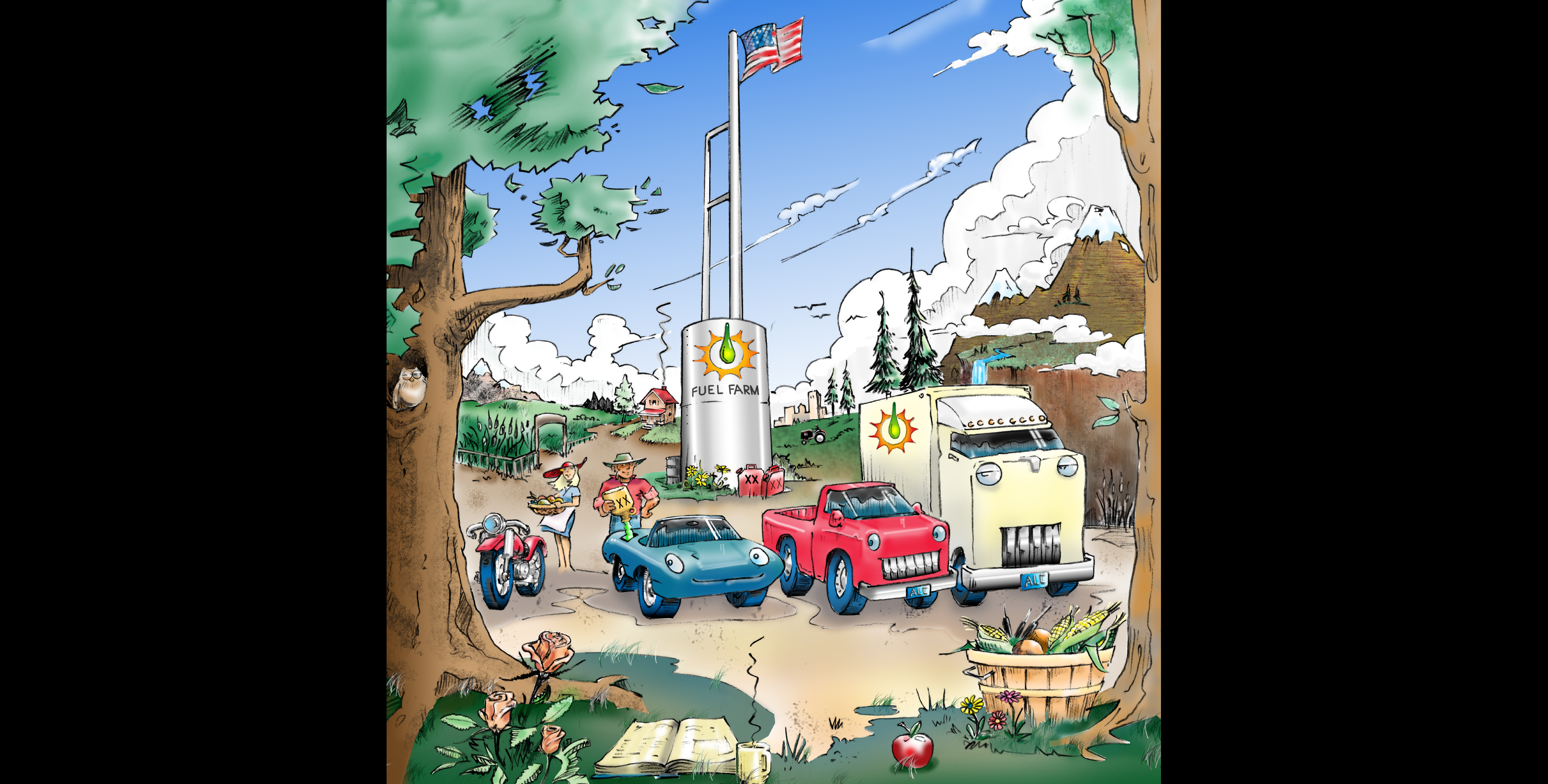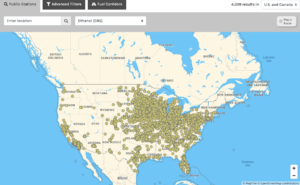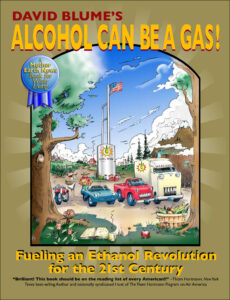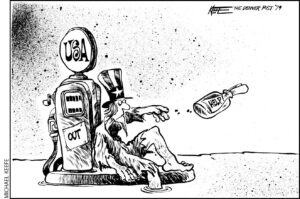
It’s time for America, and the world, to stop relying on oil. We need to start relying on ourselves for the fuel we need to run our cars and our country, and my 14-Point Plan for U.S. Energy Independence is a simple blueprint to do it. — David Blume, world-renowned expert on alcohol fuel and regenerative agriculture, and author of the bestselling book, Alcohol Can Be A Gas!
Don’t believe the myths! Since alcohol is made from plants, its production takes carbon dioxide out of the air, sequestering it, with the result that it reverses the greenhouse effect (while potentially vastly improving the soil). Alcohol fuel production and use is clean and environmentally sustainable, and will revitalize families, farms, towns, cities, industries, as well as the environment. A national switch to alcohol fuel would provide many millions of new permanent jobs. We can have a carbohydrate economy instead of a petroleum economy. We can literally put power in the hands of the people.
Alcohol fuel (ethanol) has a proud history. While gasoline is a refinery’s toxic waste, alcohol fuel is liquid sunshine. Henry Ford’s early cars were all flex fuel. It wasn’t until gasoline magnate John D. Rockefeller funded Prohibition that alcohol fuel companies were driven out of business.
Back in 1980, President Jimmy Carter fought the oil companies. He took tax money collected from the Oilygarchy by the Crude Oil Windfall Profits Tax Act, and he used it to fund alternative energy and specifically alcohol fuel.
It’s time to do it again. Let’s take Big Oil’s windfall profits and put them into a Fueling Democracy Fund, where they’ll go to work building America’s energy independence.
As we secure our own energy independence, we’ll be helping to secure democracy for the entire world, since no country will have to buy oil from thug countries once the U.S. is no longer buying oil in vast quantities. (And almost every country can itself become energy-independent. Anywhere that has sunlight and land can produce alcohol fuel.)
David Blume’s 14-Point Plan for U.S. Energy Independence
1. Create the Fueling Democracy Fund by taxing windfall profits from the oil companies.
Use the Fueling Democracy Fund to achieve U.S. energy independence by increasing local-scale alcohol fuel production, increasing alcohol fuel use, and stockpiling alcohol fuel.
Increase Local-Scale Alcohol Fuel Production:
2. Build alcohol production plants to make local alcohol.
Give the USDA a massive multi-billion-dollar fund to make loans at 1% interest to farms and businesses to build small, medium, and large alcohol plants nationwide to make local alcohol.
3. Reduce new crop certification time.
Mandate that the certification time for a new crop for alcohol production be reduced to 90 days from the nearly unlimited years it takes now.
4. Extend and increase the alcohol production tax credit.
Triple and extend the per-gallon tax credit to $3 for E100 (100%) alcohol fuel at all scales of production, to stimulate investment and capitalization of new plants. Pay for it by eliminating the Oil Depletion Allowance, an ancient subsidy to the oil industry still on the books.
5. Implement a food production waste credit.
Give alcohol producers a $2-per-gallon tax credit for turning food production waste into alcohol and thus preventing methane production in landfills.
Increase Alcohol Fuel Use:
6. Build independent alcohol fuel stations.
Create a billion-dollar fund to build independent alcohol fuel stations nationwide outside the control of oil company ownership.
7. Normalize flex fuel.
Fund research for inexpensive flex fuel device that plugs in a socket under the dashboard so people can run any percentage of alcohol they want. Also mandate that ALL new cars sold in the US both foreign and domestic be flex fuel to E100 both including hybrids. Mandate that all used non-flex fuel cars sold in the US have a flex fuel conversion installed within 10 days of arrival on a dealer’s lot. No car can be sold without one.
8. Increase % of alcohol at the pump.
Mandate all pumps go to E25 now and go up 2% a year until it reaches 30%. All cars on the road today can use 25% alcohol. Mandate all gasoline sold contain 25% alcohol instead of the current 15% while the nation upgrades all stations to blender pumps. Mandate mid level octane and high octane fuels at pumps to add 30% immediately. In this mandate require oil companies temporarily blend more volatiles in the cold season to avoid car starting problems in unmodified autos.
9. Normalize blender pumps.
Require all gasoline stations sell both regular and premium to achieve the higher octane with ethanol through blender pumps that mix alcohol and gasoline to the consumer’s choice. No toxic volatile aromatics from oil. Blender pumps draw fuel from gasoline and alcohol tanks to sell a variety mixtures of gasoline with 106 octane alcohol. This supplies all vehicles from regular to super premium. Fund this upgrade on 100,000 fuel stations across the country and mandate that all new fuel stations be designed for blending the two fuels at the pump.
10. Require heated fuel injectors.
Provide a tax credit to every driver who installs heated fuel injectors, which eliminate the need to use gasoline mixed into alcohol to assist engine starting in frigid parts of the country.
11. Require government vehicles to use E100.
Mandate that gasoline vehicles of the federal government and of state and local municipalities that receive federal funds be flex fuel to E100. Require that all new gasoline vehicles they purchase be flex fuel to E100 and that they convert older vehicles over the next year utilizing the funding from the Fueling Democracy Fund.
12. Make all pipelines alcohol-ready.
Mandate that all pipelines for fossil fuel in the US be required to be certified alcohol capable. In reality almost all of them are now, but it should be universal.
13. Replace BTX with alcohol fuel.
Ban carcinogens benzene, toluene, and xylene (BTX) and replace with clean nontoxic ethanol.
Stockpile Alcohol Fuel:
14. Create a decentralized national alcohol fuel reserve.
Unlike fossil fuel, stored alcohol never goes bad. Establish a decentralized national alcohol fuel reserve to store over 40 billion gallons (20% of annual fossil fuel use in the U.S.). Increase this percentage by an equal amount every year divided proportionately among all 50 states.





